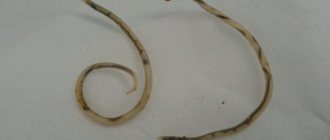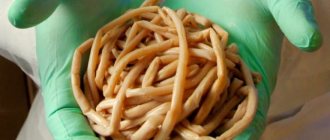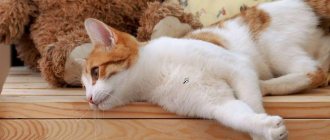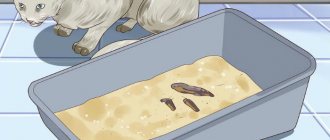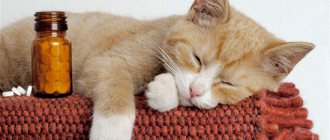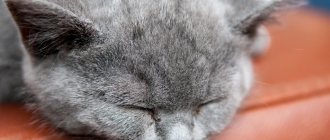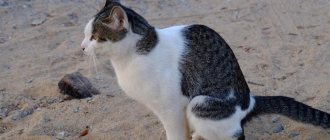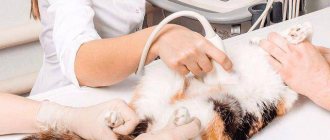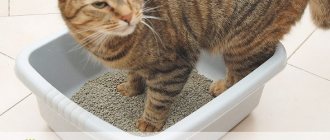Normally, the color of animal stool varies from light brown to dark brown. It is quite difficult to reliably indicate the division between dark brown and black colors, however, the truly black color of feces is not normal in cats and can indicate various pathologies. Black liquid feces are called melena. If your pet's stool color has changed to black, and previously the color was different, or additional symptoms are observed, including lethargy, changes in behavior, it is recommended to consult a veterinarian.
An animal needs immediate examination by a veterinarian if it has:
- The presence of blood clots in the stool, which is a sign of bleeding both in the upper parts of the gastrointestinal tract (stomach, small intestine) and lower (large intestine).
- Abdominal pain.
- Temperature.
- Vomiting, diarrhea.
- Lethargy, refusal to eat.
Diarrhea in a cat: what is its danger?
You always need to remember one simple rule: if diarrhea continues for more than a day in the case of an adult cat, or 12 hours or more in the case of a young animal, be sure to call a veterinarian!
What is this rule about? It's simple - dehydration. A day of diarrhea is quite sufficient time for its development.
Dehydration is fraught with many serious consequences:
- The kidneys are the first to suffer. Experienced veterinarians believe that even a single episode of moderate dehydration by a cat increases the risk of developing kidney failure by at least 40%.
- Since the blood thickens significantly when dehydrated, it is hard on the heart.
- The central nervous system (i.e., the nervous system) tolerates dehydration very poorly. Some experts believe that animals suffering from a severe degree of this pathology may develop epilepsy or other pathologies associated with the functioning of the nervous system.
Thus, after the first signs of diarrhea appear, it is necessary to take all measures to immediately eliminate this phenomenon. There is no point in delaying, as delay can be too costly for both the owner and his pet.
Diarrhea symptoms
Regardless of the etiology (i.e. origin) of diarrhea, all its types can be divided into two large types:
- Acute diarrhea.
- Chronic diarrhea.
Accordingly, the symptoms of these two varieties will differ significantly.
Signs of acute diarrhea
In this case, everything is quite simple and clear. First, you need to decide on the terminology: “acute” diarrhea is called in cases where it began suddenly and lasts no more than two days, accompanied by a significant deterioration in the condition of the sick animal.
The following signs of such diarrhea are distinguished:
- Defecation is frequent, the animal constantly runs to the tray.
- As a rule, feces are liquid; they often contain impurities in the form of mucus, half-digested pieces of food, and sometimes blood can be seen.
- After just five or six trips to the potty, the animal begins to meow hoarsely, constantly licking the anus area.
- If diarrhea continues for more than two days, the cat becomes noticeably weaker. In the most severe cases, the pet practically stops grooming itself, its fur becomes matted and becomes covered with a crust of dried feces.
- In the same cases, severe blanching of all visible mucous membranes is observed. They become dry and sticky to the touch. The skin loses its elasticity, the coat becomes rough and hard.
If such signs appear, the cat should be immediately shown to a veterinarian, since this clinical picture directly indicates a serious degree of dehydration. If you delay in contacting the clinic, the animal may die.
The following conclusions can be drawn from all of the above:
- If diarrhea lasts less than a day, and the general condition of the animal at this time remains stable and does not cause alarm, you can try to cope with diarrhea on your own.
- In cases where a cat suffers from diarrhea for more than a day, and its condition is slowly but deteriorating, you should definitely show the animal to a veterinarian. This precaution will certainly not be superfluous.
Signs of chronic diarrhea
As you can understand, “chronic” diarrhea does not imply the cat constantly sitting on the tray. In this case, the animal will simply die from dehydration and exhaustion.
This type of pathology manifests itself somewhat differently:
- Diarrhea occurs sporadically, not every day.
- Interestingly, cases of diarrhea may well alternate with periods of “impenetrable” constipation.
- The cat’s condition “by eye” remains normal, but this impression is wrong. If nothing is done and the true root cause is not identified, the animal will gradually develop exhaustion.
Main causes of diarrhea in cats
Unlike dogs, cats are creatures that are cleaner in all respects. In any case, these animals are much less likely to succumb to the temptation to empty the trash can, or to eat some half-rotten “delicacy” found on the street during a walk.
The main causes of cat diarrhea that veterinarians regularly encounter in practice are:
- Feeding on low-quality dry food. Alas, many people prefer to “save”, and such frugality backfires on their pets’ bodies. Long-term dry feeding leads to a weakening of the function of the endocrine glands of the digestive tract. In particular, the volume of pancreatic secretions decreases, and bile secretion is greatly affected. Because of this, the digestion process sharply worsens; semi-digested food masses often stagnate in the lumen of the gastrointestinal tract.
- Binge eating. The owners pamper their pets, giving them the most delicious foods. But at the same time you need to observe the measure. If you regularly overfeed your cat, its digestive system will no longer be able to cope with large volumes of food. The food will no longer be digested normally, putrefactive and fermentation processes will begin, resulting in severe indigestion and, accordingly, diarrhea.
- Poisoning. It just so happens that cats are pronounced predators, “specializing in small mouse-like rodents. But they are not liked in “decent society”, which is why they are bullied. Poisoned rodents are extremely easy prey for cats, who, having tasted this “natural product,” are poisoned. Diarrhea in this case is perhaps the most “favorable” outcome, since the animal’s kidneys or liver may well fail.
- Development of cancer. Tumors, by the way, often lead to the development of chronic diarrhea. The fact is that malignant neoplasms destroy adjacent tissues during the growth process. Accordingly, the functioning of the digestive tract is disrupted, and the risk of penetration of pathogenic microflora sharply increases.
- Liver pathologies. They are also accompanied by diarrhea. This happens due to a deterioration in the synthesis of bile, without which the normal process of digesting food becomes impossible.
- Parasitic infestations. And yes, you shouldn’t think that only “ownerless” inhabitants of garbage dumps are “stuffed” with worms. Even domestic cats, which sometimes never leave the apartment at all, often turn out to be carriers of a whole “bouquet” of parasites. And this is easy to explain. Worm eggs can end up in fish and meat; some types of helminths are carried by fleas and flies; the owners themselves bring a lot of dirt on the soles of outdoor shoes.
Causes of black feces in cats
The reasons for the change in the color of feces are the content of digested blood (from the upper intestines and stomach) in it. Scarlet blood in the stool can only be observed with bleeding in the large intestine (or superficial injuries around the anus); in all other cases of internal bleeding in the gastrointestinal tract, the blood will have time to be digested and will look black. If the pet feels well and does not have the secondary symptoms listed above, then black feces may occur if:
- the diet consists of raw meat, blood meal or contains raw liver and other similar products,
- the animal receives iron supplements or iron-containing vitamin supplements.
Black feces as a symptom of the disease accompanies the following diseases:
1. Helminthic infestation.
By parasitizing the small intestine, helminths attach to the intestinal wall, disrupting its integrity and causing minor intestinal bleeding. Moving into the thick section, the blood is digested and the stool turns black. However, in order to damage the intestinal walls, a significant level of invasion is required, that is, a very large number of parasites.
2. Hemorrhagic gastroenteritis.
This disease is an inflammatory process in the stomach or intestines with exfoliation of the epithelium and small vessels, which leads to bleeding and black stools. There can be many causes of hemorrhagic gastroenteritis, the main ones are:
- bleeding disorders,
- complication of infectious intestinal diseases - parvovirus, distemper in dogs, panleukopenia in cats.
- stress,
- autoimmune diseases,
- food intolerance.
3. Traumatic gastritis or colitis.
Most often, the wall of the stomach or intestines is injured by foreign objects, which causes wounds, microcracks and even perforation of the wall.
4. Ulcerative gastritis, ulcerative enterocolitis.
The presence of ulcers in the stomach and small intestine leads to bleeding and the appearance of black stools.
5. Tumors of the stomach and small intestine.
Tumors (lymphoma, adenocarcinoma) can also cause ulceration of the wall of the stomach and intestines with the appearance of blood.
The range of diseases that lead to this symptom is very wide, so a visit to the doctor and additional diagnostics are necessary.
How to guess the causes of diarrhea by its color?
We talked above about the presence of impurities, but the color of stool may be an even more valuable sign. Moreover, any owner will be able to evaluate it, while most likely not everyone will be able to find mucus in feces.
Green diarrhea in a cat
Green color is good for grass, but if this shade is acquired by feces, the matter is clearly unclean. The problem is that the “greening” of feces is a pronounced sign indicating putrefactive and fermentative processes occurring in the intestines.
Causes of changes in stool color
The color of excrement in a kitten or cat without the disease is brown. Otherwise, you should be wary, paying attention to the accompanying signs.
© shutterstock
So, depending on the color and consistency of an animal’s excrement, it can be assumed that it has the following health problems::
- Black feces indicate the appearance of worms, the development of gastritis, the formation of a tumor or ulcer in the gastrointestinal tract. At the same time, the cat’s temperature rises, he experiences stomach pain, refuses to eat, and vomits.
- The yellow color of the excrement, if it is too saturated, indicates that the cat has jaundice.
- White diarrhea appears due to a lack of bilirubin. The reason for this is impaired liver function.
- Greenish feces in cats cause fermentation or rotting in the intestines. This may happen because the animal has eaten rotten food. In this case, he may be at risk of poisoning.
If a cat has dark green liquid stool, accompanied by mucus or blood, this indicates the development of an inflammatory process in the gastrointestinal tract. The appearance of a symptom such as the stench of green discharge indicates an acute form of infection.
Treating diarrhea at home
In principle, many types of diarrhea can be dealt with at home, but much depends on the type of diarrhea and the physical condition of the cat.
If the animal is very weakened and is literally “tossed” by the wind, it is better not to risk it: you need to immediately show the pet to the veterinarian, subsequently acting on his instructions.
You can treat a cat at home, but only if the following conditions are met:
- The pet feels normal, there are no frightening oddities in her behavior or appearance.
- The animal retains its appetite and, most importantly, thirst.
- Visible mucous membranes are pink and shine in the light (this indicates the absence of severe dehydration).
For “home” therapy, you can use fairly common medications sold in any pharmacy. As a rule, the remedies used to relieve digestive disorders are quite universal and, when used correctly, are not dangerous to the health and life of cats. We will describe some of them below.
Uses of Loperamide
One of the most common and effective anti-diarrhea drugs. Please note that “Loperamide” is not the only name for this medicine. In particular, “Imodium”, as well as various products that have the part “Kaopectate” in their names, are exactly the same. The difference is not in the active substance, but in the commercial registration of drugs in the local and international pharmaceutical markets.
The dosage must be strictly observed - no more than 0.05 mg of active substance per 0.4 kg of live weight. The frequency of delivery is once every eight hours. The course of treatment should not exceed two days; failure to comply with this rule may result in poisoning or the development of extremely severe, “impenetrable” constipation.
We recommend that you consult your veterinarian before using this medication. Diarrhea should not be treated with Loperamide if:
- The animal is severely weakened and exhausted, as this will almost certainly lead to severe poisoning and other negative consequences.
- There is at least the slightest suspicion of poisoning (i.e. in cases where diarrhea is caused by poisoning).
- The animal experiences severe pain.
- The use of medicine to relieve diarrhea in pregnant and lactating cats is strictly prohibited.
Enterosgel for diarrhea in a cat
The drug belongs to the group of sorbents. This means that the principle of its action is based on absorption, “suction” of toxins and other harmful substances. In addition, Enterosgel, no different from other drugs of the same group, belongs to chemically neutral compounds. It does not react with substances contained in gastric and intestinal juices, and does not “compete” with other drugs.
The product is available in the form of a semi-liquid substance, which veterinarians advise diluting with boiled water at room temperature before use. Dilution ratio – 1:1. Under no circumstances should you use water with a temperature of more than 30° Celsius to dilute the medicine! It is believed that in this case the efficiency of the sorbent is significantly reduced.
For one cat there is approximately half a teaspoon of undiluted drug. Accordingly, for large animals the dose can be increased to one spoon, but veterinarians advise giving kittens no more than ¼ at a time. This is a daily dose, which can be divided into two or three doses. You should not “pour” too much of the drug into your pet, as he may subsequently develop severe constipation.
Activated carbon
The well-known and widely used activated carbon also belongs to the group of sorbents. It is obtained by pyrolysis of deciduous wood. The drug has an impressive ability to absorb “foreign” substances, not much inferior to modern (much more expensive) analogues.
The dosage is extremely simple - take one tablet for every kilogram of live weight. In case of severe diarrhea and suspected poisoning, the dose can be increased to two pills per kilogram, there is nothing wrong with that.
Coprogram with identification of helminths
Coprogram is a type of laboratory test of stool that allows you to evaluate some aspects of the functioning of the digestive system.
What is feces?
The material under study is a product obtained as a result of the movement of food masses (and digestion/absorption of liquid) through the gastrointestinal tract. Feces are the contents of the large intestine that are released during bowel movements. In a healthy animal, feces contain 75-80% water and 20-25% solid residue. The dense part consists of 1/3 of the remains of ingested food, 1/3 of the remains of the excreted gastrointestinal tract, 1/3 of microbes, about 30% of which are dead.
Why is it necessary to make a coprogram?
Along with other laboratory tests on animals, stool analysis is performed in our veterinary clinic. This type of study, together with a biochemical blood test, is necessary to identify pathologies of the gastrointestinal tract and liver. With its help, inflammatory diseases, invasive (helminthiasis) diseases, protozoan microorganisms, malabsorption in the intestine, impaired flow of bile into the duodenum, and impaired functioning of the pancreas are detected. Also, fecal analysis is included in the list of standard studies carried out during the annual medical examination of animals.
How to prepare an animal for testing?
In most cases, stool analysis is carried out without special preparation, but it is recommended 2-3 days before the test to avoid taking medications that change the nature of stool and cause functional disorders of the gastrointestinal tract (iron, bismuth, laxatives). The time from defecation to examination should be no more than 12 hours (when stored in the refrigerator), and in some cases - no more than 20-30 minutes (when diagnosing parasitic diseases).
What research does a coprogram include?
The analysis includes macroscopic, microscopic and simple chemical studies. Microbiological examination of stool is carried out if an infectious intestinal disease is suspected.
1. Macroscopic examination
• Consistency and shape of stool:
The feces of a healthy animal have a dense consistency and a cylindrical shape. A simple examination of feces allows you to detect adult helminths, segments of tapeworms, determine the nature of the animal’s feeding, the presence of undesirable components (sharp bones, sticks, ropes, polyethylene, etc.). Consistency depends on the amount of water, fiber, mucus and fat. Dense, well-formed feces are excreted in healthy animals. The ointment-like consistency is caused by a violation of pancreatic secretion (acute pancreatitis, pancreatic necrosis, cystic fibrosis). Feces become hard when the rate of movement of chyme through the intestines decreases. Liquid feces accompany insufficient digestion in the small intestine with enteritis, accelerated evacuation, and colitis with ulcerations. Feces become mushy in cases of fermentative dyspepsia, colitis, and chronic enterocolitis. The foamy character is acquired as a result of fermentative colitis, dysbiosis, dysbacteriosis. Feces acquire a ribbon-like, pencil-shaped shape in the presence of hemorrhoids, spasm of the rectal sphincter, anal fissure, or rectal tumor.
• Smell
caused mainly by protein breakdown products. A putrid odor appears with insufficiency of gastric digestion, putrefactive dyspepsia, and ulcerative colitis. Fetid (smell of rancid oil) - due to impaired secretion of lipase by the pancreas, lack of bile flow. The sour smell is caused by fermentation processes in the large intestine and impaired absorption of fatty acids in the small intestine.
•Color
- with a mixed diet - brown, with a meat diet - darker, with fermentative dyspepsia - yellow feces, with putrefactive dyspepsia - dark brown.
The color of stool is normally brown, normally it becomes yellow with a dairy diet, and dark brown with a meat diet. Feces become black in color when there is bleeding in the anterior gastrointestinal tract (stomach, duodenum and small intestine). Dark brown is observed with insufficiency of gastric digestion, putrefactive dyspepsia, colitis with constipation, colitis with ulcerations, and increased secretory function of the colon. The stool becomes light brown due to accelerated evacuation from the colon. The reddish color is due to the presence of bleeding in the posterior gastrointestinal tract. Yellow color is observed with insufficient digestion in the small intestine and fermentative dyspepsia. The gray color is due to pancreatic insufficiency. Stool becomes white due to intrahepatic stagnation or complete obstruction of the common bile duct. • Stool reaction
is slightly alkaline, less often neutral or slightly acidic (PH 5.5 - 7.0). Pronounced alkaline reaction - with putrefactive dyspepsia, due to increased processes of protein putrefaction. The acidic reaction is due to the presence of free organic acids in the feces, resulting from the fermentation of carbohydrates and the release of fats by microbes of butyric acid fermentation during fermentative dyspepsia. The intensification of the processes of bacterial decomposition of proteins (rotting) is accompanied by the formation of ammonia, which gives the feces an alkaline reaction, and the intensification of fermentation processes is accompanied by the release of CO2, organic acids and a shift in pH to the acidic side.
Insufficient digestion of proteins in the small intestine or pancreatic insufficiency, as well as the release of inflammatory exudate (colitis) into the intestinal lumen activate the putrefactive intestinal flora, and the fecal reaction becomes sharply alkaline.
Insufficient digestion and increased intestinal motility during enteritis contribute to the activation of fermentation microflora, and the stool reaction becomes acidic.
Mucus in stool. In healthy animals, feces are always covered with a thin layer of mucus with single columnar epithelial cells. The appearance of mucus in the form of flakes with a significant amount of intestinal epithelium, leukocytes and erythrocytes indicates an inflammatory process in the intestines.
2. Microscopic and bacterioscopic examination
•Helminth eggs, protozoa or their cysts
detected using the flotation method. You can also detect artifacts (entered into the feces from the outside, such as fleas, ticks, etc.). Examination of stool for parasites reveals helminth infections (toxocariasis, toxascarosis, various types of tapeworms), as well as giardiasis (giardiasis is a small protozoan that lives in the large intestine and causes inflammation). This study makes it possible to effectively select anthelmintics (drugs for worms) and draw up a therapeutic deworming regimen, as well as monitor the effectiveness of treatment for helminthiasis and giardiasis.
•Muscle fibers
— usually divided into: changed and not changed. A characteristic feature of altered muscle fibers is the absence of transverse striations. Normally, only small amounts of altered muscle fibers are detected. The detection of unchanged muscle fibers in the feces indicates: insufficiency of the function of the stomach and pancreas, insufficiency of digestion in the small intestine and accelerated evacuation.
•Plant fiber
— distinguish between digested and undigested fiber. Digested fiber is that part of the fiber that is broken down under the influence of the microflora of the ileocecal intestine. Normally, it is usually not detected. The amount of undigested fiber in feces depends on the amount of food entering the digestive tract that is rich in indigestible fiber. A lot of digestible fiber for fermentative and putrefactive dyspepsia.
•Fat in stool.
Fats from food, both animal and plant origin, are absorbed almost completely under conditions of normal digestion. In the feces of a healthy animal, fat is detected in small quantities in the form of fatty acids, their crystals and soaps. The appearance of neutral fat or abundant amounts of fatty acids, their crystals and soaps in the feces indicates insufficient function of the pancreas, liver, obstruction of the biliary tract or rapid evacuation of food masses from the intestine, insufficient digestion in the small intestine. A significant amount of soaps and fatty acids is found in fermentative dyspepsia.
•Starch
- Normally there is no starch in feces. In case of digestive pathology, it is found in digested fiber in the form of intracellular or extracellular grains. Starch appears in significant quantities when there is insufficient digestion of carbohydrates due to pancreatic disease: extracellular starch is of especially great diagnostic importance in this case. A lot of starch for fermentative dyspepsia.
•Connective tissue
— there is no connective tissue in the feces of healthy animals under conditions of complete digestion. Its appearance is associated with insufficiency of gastric digestion, i.e. lack of hydrochloric acid in gastric juice.
Main syndromes of gastrointestinal diseases and interpretation of coprogram
| Syndrome | Signs | Treatment |
| Gastric failure | Muscle fibers, starch grains. | Abomin, Pepsidil |
| Insufficiency of bile secretion | Undigested fat, fatty acid crystals. | Festal, digestal, choleretic |
| Pancreatic insufficiency | Copious stool, large amounts of neutral fat. | Pancreatin, Panzinorm, Cholenzym. |
| Enteritis syndrome | Muscle fibers, starch, undigested fiber, mucus, iodophilic flora. | Panzinorm, mezim-forte, pankurmen. |
3. Chemical examination of stool
•Reaction to occult blood
(Gregersen district). Determination of hidden blood in the stool has important diagnostic value, especially in case of “hidden” gastrointestinal bleeding, when blood in the stool is not macroscopically detected.
•Reaction to bile pigments
(bilirubin, stercobilin). Stercobilin is the end product of the reduction of bilirubin, released into the intestine from the common bile duct, and gives animal feces a characteristic brown color. Stercobilin is present normally (it is released depending on the weight of the animal, 20 – 350 mg/day). The absence or sharp decrease in the amount of stercobilin in the feces (acholic feces) most often indicates obstruction of the common bile duct with a stone, compression of it by a tumor, or a sharp decrease in liver function (for example, in acute viral hepatitis). An increase in the amount of stercobilin in feces occurs with massive hemolysis of red blood cells or increased bile secretion. The detection of unchanged bilirubin in the feces of cats and dogs indicates a disruption in the process of restoration of bilirubin in the intestine under the influence of microbial flora. The most common causes of this disorder are: suppression of the vital activity of intestinal bacteria under the influence of large doses of antibiotics (intestinal dysbiosis), a sharp increase in intestinal motility.
•Triboulet reaction
— determination of soluble protein. During digestion, proteins are broken down and absorbed. Therefore, soluble protein, as a rule, is not found in the feces of healthy people. It appears during inflammatory processes or ulcerations in the small and large intestines.
What to feed a cat during diarrhea
Note that in the first day after the onset of diarrhea, the pet should be put on a starvation diet, without restricting water. Such a “fast” is needed so that during the rest period the animal’s digestive system returns to normal.
Remember that serving fatty or heavy food at this time is almost 100% guaranteed to provoke a new attack of diarrhea, worsening the cat’s already not “brilliant” condition.
But still, what should you feed your pet so as not to burden its gastrointestinal tract, but at the same time not starve it? Even among experienced veterinarians and breeders there are many opinions on this matter, but the “average optimal value” can be deduced from their recommendations:
- Boiled rice. It is best to use round varieties, boiling the product to a semi-liquid pulp. This consistency has a positive effect on the condition of the long-suffering intestinal mucosa without further irritating it. The pet should be fed this for the first day or two.
- Chicken bouillon. The better the cat becomes, the more saturated broths can be used. We warn you once again that at first it is extremely undesirable to use fatty foods, as they will almost certainly cause a violent relapse of diarrhea.
- Boiled chicken. It is advisable to use the breast as the least fatty part. It is necessary to constantly monitor the cat’s well-being and, if signs of stool liquefaction appear, reduce the amount of meat in its food.
- High-quality low-fat offal. But this must be done as carefully as possible, starting from the first week after the last attack of diarrhea.
- Finally, to relieve bouts of diarrhea, you can use pumpkin puree from baby food. The dose is approximately half a teaspoon at a time. The duration of submission is approximately three days.
Associated symptoms of diarrhea in cats
In addition to loose green stools, the following symptoms may indicate diarrhea::
- Increased body temperature.
- Change in animal behavior.
- The cat is thirsty all the time.
- The pet's body weight decreases.
- The quality of the cat's fur becomes poor.
- The mucous membranes of the animal turn pale.
- Appetite disappears.
© shutterstock
Green stool in a kitten with a liquid consistency, turning into a chronic condition, leads to dehydration of the animal’s body and the accumulation of toxins in it. In this case, metabolic processes are disrupted. The kitten's growth and development slow down.
Preventing Feline Diarrhea
It is quite difficult to recommend something specific, since diarrhea in cats can be caused by many negative factors, and it is quite difficult to protect your pet from them, and this may not be possible in all cases. Thus, typical prevention largely copies the “average” recommendations of veterinarians:
- It is always necessary to vaccinate your pets in a timely manner, since many dangerous infectious diseases cause not only diarrhea, but also much more serious consequences.
- For the same reasons, it is necessary to carry out preventive treatment of cats with anthelmintic drugs at least once a quarter. And this must be done regardless of the conditions of keeping and feeding the animal. Worm eggs can enter the pet’s body at any time, and it is most likely impossible to completely protect the cat from parasites.
- You need to carefully monitor the quality of food used to feed your cat. You should not save money by purchasing cheap dry food of dubious origin, since the “saved” money will subsequently have to be given to the veterinarian tenfold. If possible, we advise you to consult a veterinary nutritionist. If the animal’s diet is compiled by a specialist, the likelihood of digestive disorders can be reduced several times.
- Finally, you need to make it a habit to observe your cat's behavior for at least five or ten minutes every day. If the owner is thoroughly aware of all the characteristics of his pet, he will react much faster to signs of something wrong and immediately report it to the veterinarian.
